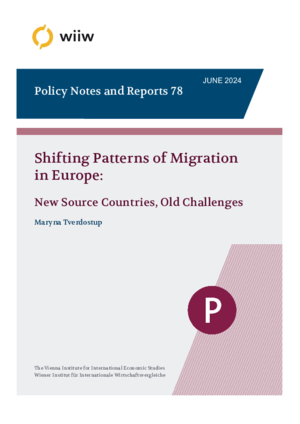Shifting Patterns of Migration in Europe: New Source Countries, Old Challenges
wiiw Policy Note/Policy Report No. 78, June 2024
34 pages including 16 Figures
Over the past few decades, immigration has become the primary factor contributing to population growth in the European Union (EU) due to rapid population ageing and declining fertility rates. However, the traditional migration source countries – namely, the EU countries in Central and East Europe (EU-CEE) and the EU neighbourhood countries – have limited potential to supply much-needed labour to Western Europe due to own their grim population prospects. Immigration from non-EU, non-European Free Trade Association (EFTA) or non-EU candidate countries as of 2015 (i.e. Georgia, Moldova, Turkey and Ukraine) appears to be the only factor that can prevent population decline in the long run, as third-country nationals are, on average, younger than natives or immigrants from the EU neighbourhood. However, current evidence suggests that higher immigration has only a limited capacity to stabilise population decline and offset labour shortages in the EU countries most affected by negative demographic trends, as they receive fewer immigrants relative to other EU countries. Moreover, the labour market integration of immigrants from non-traditional source countries, including Middle Eastern and African countries, has proved challenging for both legal and infrastructural reasons. This has resulted in an immense pool of untapped talent and skills, which will require the appropriate policy steps to be fully identified and effectively employed in the labour market. These policies, like the ones proposed in this report, will become increasingly important as the EU moves steadily towards new immigration source regions.
Keywords: demographic trends, labour shortages, migration, refugees, integration policies
JEL classification: J11, J15, O15
Countries covered: European Union, EU candidate countries, EU Member States, non-EFTA, non-EU, non-EU candidate countries (as of 2015)
Research Areas: Labour, Migration and Income Distribution
